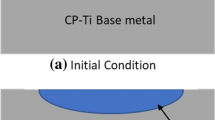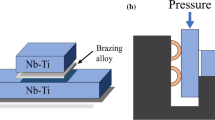Abstract
An analytical model has been established to evaluate the thickness of the dissolution layer of base metal in a liquid brazing filler metal during a high temperature brazing process. The model was validated by a study of brazing of a TiAl alloy to a 42CrMo steel. Peak brazing temperatures were within a range of 1103–1203 K. The margin of deviation between predicted and experimentally determined dissolution thicknesses is within the range of 1–14 %, thus supporting the validity of the model well.




Similar content being viewed by others
References
Wu ZY, Yeh TY, Shiue RK (2010) ISIJ Int 50:450
Zhang Y, Yan J, Chen X (2010) Trans Nonferr Met Soc China 20:746
Chada S, Fournelle RA, Laub W (2000) J Electron Mater 29:1214
Singler TJ, Su S, Yin L, Murray BT (2012) J Mater Sci 47:8261. doi:10.1007/s10853-012-6622-9
Dezellus O, Voytovych R, Li APH et al (2010) J Mater Sci 45:2080. doi:10.1007/s10853-009-3941-6
Nylen M, Gustavsson U, Hutchinson B (2002) Mater Sci Forum 396:1585
Zhang XP, Shi YW (2004) Scripta Mater 50:1003
Lashko NF, Lashko SV (1977) Contact metallurgical processes in soldering metals. Metallurgy Press, Moscow
Shiue RK, Wu SK, Chen SY (2003) Acta Mater 51:1991
Yang Z, He P, Zhang L (2011) Mater Charact 62:825
Chan HY, Liaw DW, Shiue RK (2004) Mater Lett 58:1141
Valenza F, Artini C, Passerone A, Muolo ML (2012) J Mater Sci 47:8439. doi:10.1007/s10853-012-6790-7
Lee JG, Lee JK, Hong SM, Lee MK, Rhee CK (2010) J Mater Sci 45:6837. doi:10.1007/s10853-010-4923-4
Zhang HR, Ghoneim A, Ojo OA (2011) J Mater Sci 46:429. doi:10.1007/s10853-010-4884-7
Li YL, He P, Feng JC (2006) Scripta Mater 55:171
Mannan S, Clode MP (2004) Solder Surf Mt Technol 16:31
Izuta G, Tanabe T, Suganuma K (2007) Solder Surf Mt Technol 19:4
Takamoto T, Uetani T, Yamazaki M (2004) Solder Surf Mt Technol 16:9
Wassink RJK (1984) Soldering in electronics, 2nd edn. Electrochemical Publications Ltd., Ayr
Appel F, Wagner R (1998) Mater Sci Eng R 22:187
Acknowledgements
This work was supported by the National Natural Science Foundation of China (No. 50975062), the Science Foundation of Educational Department of Jiangxi Province (No. GJJ10033), and the Funding for Young Scientists of Jiangxi Province (2010DQ01000), China. The first author (YL) acknowledges support from the China Scholarship Council for a visiting scholar position in the Brazing Laboratory of the College of Engineering, the University of Kentucky. The logistics and facility support of the Institute for Sustainable Manufacturing at the University of Kentucky are acknowledged as well. The work of Prof. D.P. Sekulic and W. Liu has been funded by the US National Science Foundation under grant CBET-123581 for 2012.
Author information
Authors and Affiliations
Corresponding author
Rights and permissions
About this article
Cite this article
Li, Y., Liu, W., He, P. et al. Dissolution of TiAl alloy during high temperature brazing. J Mater Sci 48, 5247–5252 (2013). https://doi.org/10.1007/s10853-013-7315-8
Received:
Accepted:
Published:
Issue Date:
DOI: https://doi.org/10.1007/s10853-013-7315-8




